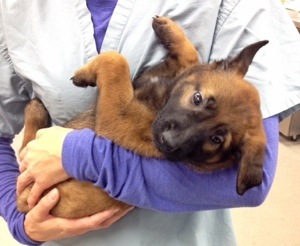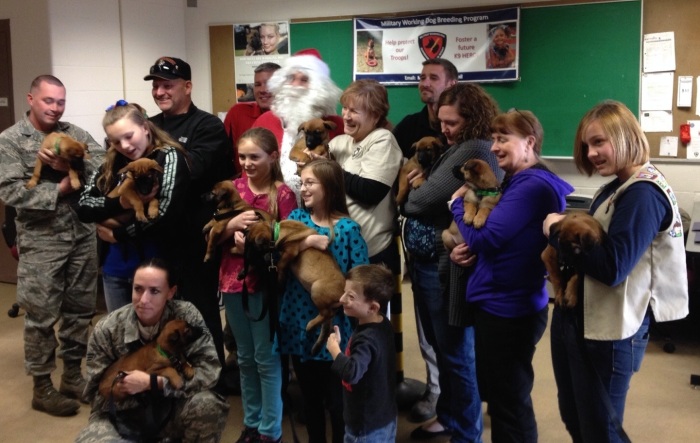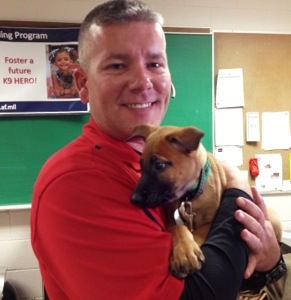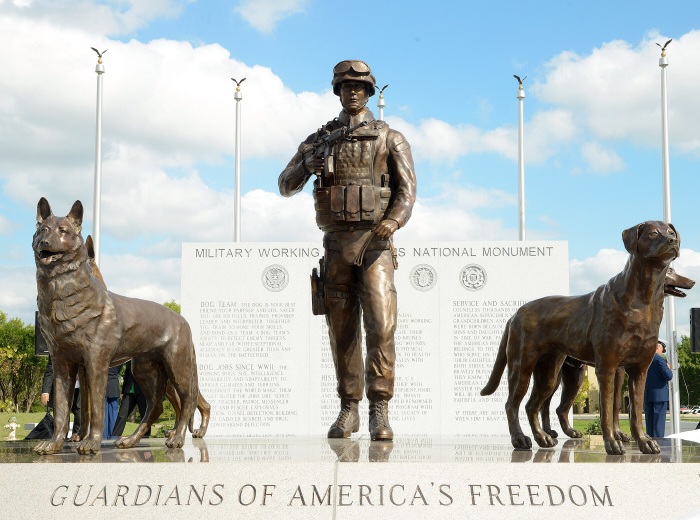Fostering Heroes – Meet the family raising Military Working Dogs
Always watching with sharp eyes, sharp ears and all senses in tune. Protecting our nation on the front-lines of Afghanistan, in our airports, on our streets and in our backyards. These warriors are fierce, powerful, highly trained and ready for action.
But before they can serve our nation, they have to stop being so darned cuddly and definitely get housebroken.
And just as it takes a village to raise a child, the same goes for raising a Belgian Malinois to be a military working dog.
For Dr. Stewart Hilliard, Perry “Shawn” Geurin and the breeding program team at the 341st Training Squadron on Joint Base San Antonio-Lackland, every day is devoted to breeding and raising America’s next generations of four-legged heroes.
The Department of Defense hired Dr. Hilliard in 1998 to start the military working dog breeding program in April of that year at then Lackland Air Force Base.
Hilliard’s background in breeding and raising dogs combined with his Ph.D. in behavioral neuroscience, “a fancy way of saying animal learning” said Hilliard, made him the perfect candidate to lead the program and why he’s been in the job ever since.
Why start a military working dog breeding program?
For years prior and through today, according to Hilliard, a tall man with salt-and-pepper hair who looks ready to work with the dogs at any time in his working boots, camo pants and layered long-sleeve shirts, the DOD would purchase MWDs from breeders in Europe where they have at least 100 years of raising and breeding these working dogs, such as police dogs.
In the late 1990’s, after decades of bringing in dogs from Europe, the DOD saw a need to breed and raise their own in response to the nations growing need for dogs.
“Dogs are really surprisingly important to the modern military,” said Hilliard. “We think of this as an age of high technology: Satellites, GPS, computers and technologies of all kinds and it is a surprising fact that dogs, properly trained dogs, especially explosives detecting dogs, are still the single most effective countermeasure against the kinds of things that people use to try to hurt our people.”
“A good bomb detector dog is still the most flexible, the most efficient, the most cost effective means for us to find IEDS and things like that.”
According to Hilliard, while the MWD bloodlines and training theories are European in origin, the DOD models their breeding program on the way seeing eye dogs and similar service dogs are raised.
It’s a community approach. The DOD “essentially leverages volunteer labor to get the dogs raised,” said Hilliard.
“The puppies go through three phases of life, and there is a team of people around them every step of the way,” said Geurin, former active duty Navy and Air Force police officer, and now Air Force civilian.
Love for the job and for these dogs permeates the program.
First, the whelping staff that works with the mothers through the pregnancy and helps with their newborn pups. This team is hands on, 24/7 with the dogs through the first 6 weeks of their lives.
Kimberly Davis, puppy development specialist working at JBSA-Lackland since 2007, has worked in all departments of the military working dog program and now is here in the whelping kennel.
Sitting in her scrubs in the lobby of the whelping kennels; a nondescript building with a bucket of bleach out front to wipe your shoes off in to prevent any germs from reaching the pups. The puppies themselves were visible on the monitors in the corner, playing and sleeping in their rooms. At this age, 6 weeks, they had been separated from their mothers in anticipation of their fostering that began the following week.
Davis sat down to talk about why she loves her job.
She pointed the screen above her.
“They are fun, cute and adorable and they need someone to take care of them,” said Davis.
 (In the picture, Davis holding UUxar, aged six weeks. She asked not to have her face on camera.)
(In the picture, Davis holding UUxar, aged six weeks. She asked not to have her face on camera.)
They are always learning, imprinting and discovering things, said Davis and she gets to experience it all up close.
“There is a lot of work involved too, they need feeding, bathing, sometimes medication, have to ensure the health and welfare of these guys.”
“It’s a lot of work. There are many rewards to it, I mean, who doesn’t love puppies?”
This staff is involved from day one through the day they leave for their foster families (at six-and-a-half weeks).
After that comes the foster stage, where Geurin is the unit lead.
Foster families have been part of the program since the very beginning and without the fosters, the program could not run, said Hilliard.
Fosters are that volunteer labor that helps the DOD raise well-adjusted puppies for military service.
During this phase in a young dogs life, from six-and-a-half weeks to seven months it’s not just military personnel who play a vital role. Every potential future working dog born in the unit will spend time with a foster family.
After the foster stage, the dogs return to base to begin months of training and testing to become military working dogs.
The goal of the foster program and those months spent ‘outside the wire’ is to socialize the puppies and instill some basic skills like house training and the building blocks of military training through weekend courses on the base.
To Hilliard’s surprise, the people who have volunteered to foster the puppies have become very committed to the task.
“Our most productive volunteer has raised 13 or 14 puppies for us,” said Hilliard. “That’s six or seven years of her life with one our puppies in her home.”
According to Hilliard, Geurin and fosters interviewed for this story, the fosters have become their own community with a (private) Facebook page they run separate from the official Facebook page for the program, DoD MWD Breeding Program.
“It’s like a club,” said Hilliard. “These people are completely committed to this.”
“I think its a combination of being devoted to what we do, and thinking [they] are making a valuable contribution to the military, supporting the military, national defense and all that,” said Hilliard. “It’s [their] patriotic thing to do.”
“And some people just love having puppies around.”
Anyone living within two hours drive of the base is eligible to apply.
(You can find the application through the 37th Training Wing Website.)
After a family/individual passes all the necessary requirements, including a home visit by Geurin they get to play a part in raising a hero.
The goal is to ensure puppy safety and that their family life is supportive of raising a puppy, i.e. having no more than 3 other dogs/pets and no children under the age of 5.
Fosters then become part of the “breeding program family” and Geurin and his team are there every step of the way.
“I always have my ‘bat-phone’ on,” said Geurin. “My job is to guide them through those months of fostering.”
The fosters also lean on each other for advice and play dates. Their Facebook group, comprised of over 100 former and current fosters, built a community to help them serve their country through this program.
Marie Takeshita, a foster since 2011 and Air Force Master Sgt. working at Wilford Hall Ambulatory Surgical Center as an operating technician, has fostered 4 dogs of her own and “baby-sat” dozens of them.
The puppies can’t leave the local area so if a foster has to go away, there are plenty of past fosters who volunteer to babysit.
“We have a great support network, the fosters are never alone,” said Takeshita.
Asked why she does it, Takeshita said;
“It’s very rewarding to know that the dog that I helped foster and grow, and learn a little bit of the basic obedience training, is going to go out there and save people’s lives.”
A new foster period began Dec. 11 for the 13 (combined) puppies of the “TT4″and “UU4” litters. Each litter is named alphabetically making these the 98th and 99th litters born in breeding program.
The puppies, all named alphabetically with a double “TT” or “UU” to start their names, were born two days apart.
The dogs are named in honor of fallen working dogs, trainers, technicians, active duty military members, and others.
One of these puppies is named after Geurin’s first working dog partner from his days in active duty, Tara.
(Shawn Geurin on the right with Ttara the puppy named for his first working dog partner. Click here to watch a video of Geurin with Ttara talking about the naming process.
Among those who lined up to serve their country and foster these puppies, a phrase that Geurin does not through around lightly, is a 13-year old Girl Scout.
“Here she is already serving her country as a scout, and she volunteers to foster,” Geurin said. “She took the lead and got her family to support her. It’s so great to see.”
Phoebe Webb, along with her parents Cody and Heather, were excited to get their puppy UUxar.
Phoebe’s using the foster program as a way to earn her volunteer project this year for the Girl Scouts.
“I learned about the program through a silver award committee member,” said Phoebe. “She sent my troop a list of silver award project ideas, and fostering a puppy was really something that interested me. I really love dogs and had been wanting one for a really long time, so it seemed like a great choice for my project.”
Her parents came on board and were very excited to help their daughter. The Webbs have waited since the spring to foster a puppy. The program did not have any litters available for months due to the effects of sequestration on the DOD budget.
“It was a little overwhelming at first,” said Heather when Phoebe first came to her about fostering. “But she had such enthusiasm and passion for this project. She wanted to do this no matter what, even if it didn’t work for her silver award project. We decided to get behind her and support her because she was so excited about the program.”
The family had no connection to the base prior to this experience.
“It’s a great opportunity to help serve and support our troops,” said Heather.
Her daughter Phoebe was ready to serve and knew that this would not be an easy job.
“I am a little nervous about having so much responsibility, but I’m also extremely excited,” Phoebe said. “I’ve been waiting a long time for this, and I’m so happy that it is finally happening.”

(The fosters with the TT4 and UU4 puppies on Dec. 11)
The opportunity to serve the nation and support the military was a common theme talking to fosters. What was also common was the use of the word family to describe the community of people who raise, foster and train these dogs.
A community of people forged around a common purpose: Raising the next generation of American military working dogs, four legged heroes who are on the front lines everyday.
(Photo below of the Military Working Dog Team Monument on JBSA-Lackland. The monument was unveiled Oct.28. U.S. Air Force photo by Benjamin Faske )

